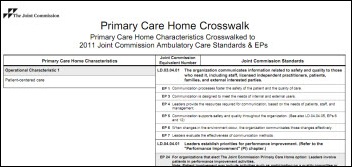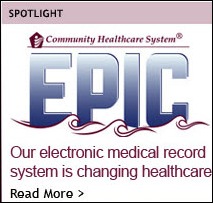Traditionally Professional Courtesy is something that physicians gave each other - but we had to be careful with it when…
News 2/11/11
From HL7RN: “Re: result messages. I’ve submitted two flavors of this question to ONC and received no response – do you think your readers would help me out with their opinions? My hospital interfaces our best-of-breed ancillary systems to our certified EMR. Since the EMR doesn’t rebound the results to outside providers, we use our interface engine to send exact HL7 copies of result messages to a third-party vendor, who then forwards them to physician offices. Does this qualify for sharing electronic data for other providers or do we need to send the data directly from the EMR?” The floor is open.
From Cabana Boy: “Re: penetration testing companies. Who are the top one or two firms in the healthcare market?”
From DrFeiedFan: “Re: Craig Feied. Calling him a vendor hack just because he works for Microsoft misses the fact that he’s a giant in informatics.” I don’t think HITworker said that; he suggested that people with Microsoft ties were overrepresented on the PCAST committee that recommended a national healthcare architecture that’s darned close to what Microsoft is selling. I think it’s a fair question, just like you’d ask when Wall Street types help draft financial policy. He’s brilliant, no doubt – drag the video timeline above to about the 37:50 mark.
From Dr. Herzenstube: “Re: Primary Care Home. Making good on their threat, Joint Commission has come out with proposed requirements for their version of the Patient-Centered Medical Home. Getting my attention: (a) practices would have to provide language translation at their own expense; (b) they would have to ‘facilitate access’ to dental care; (c) they would have to use e-prescribing, which doesn’t have much to do with the PCMH model; and (d) they would have to provide 24/7 appointment scheduling, prescription refill requests, and general health information (they probably have online resources in mind, but can you imaging a 3 a.m. page for a Viagra refill or outstanding balance request?) It’s nice to see a truly grassroots movement in health care, proven in multiple controlled trials, getting some recognition. I suppose that some kind of accreditation is necessary for reimbursement, but I do wonder how much the spirit of the thing will be lost in reductionism into atomic functions that this kind of approach fosters.”
Listening: the just-released first album of The JaneDear Girls. It’s classified as “new country,” meaning it’s radio-friendly, overproduced pop with an occasional hint of banjo or unconvincing Southern accent (one of them’s from Utah, for God’s sake). I’m not a big fan of the genre, but this is pretty good in a Lady Antebellum or Taylor Swift sort of way. They’re young, cute, and chipper, so naturally they’re going to be massively popular except with fans of real country music.
If you haven’t completed my just-once-a-year reader survey, would you mind? It’s all I use to plan HIStalk for the next year.
Is is my imagination, or is HIMSS spamming the heck out of my work e-mail? I’m getting multiple e-mails every day urging me to attend the conference, which would be coming a bit late if I wasn’t already signed up, but thus being pointless since … I’m already signed up. I promise I won’t forget to show up.
Community Healthcare System (IN) goes live on its $40 million Epic implementation.
RelayHealth is running a Facebook contest to send Dr. Jayne a welcome basket. You suggest an under-$25 “fun gift to give her to express support for her new role,” and if other Facebookers like your idea, you get a stainless steel mug and other goodies while Jayne gets the gift you suggested. Sure, it’s obviously social network marketing, but I thought it was pretty fun when they e-mailed me about it earlier today.
SCI Solutions is another non-exhibiting HIStalk sponsor who would be happy to meet with folks interested in their solutions for access management. Contact Stuart Hammond to set up a time.
Canada Health Infoway sets up a $380 million fund to co-fund EMRs and invest in peer support networks throughout Canada.
Thanks to Aspen Advisors for supporting HIStalk as a Platinum Sponsor. I just finished interviewing founder Dan Herman if you need some background. The Pittsburgh-based consulting firm offers services that include strategic planning, system selection, implementation, facility expansion, informatics, physician strategy, healthcare reform planning, infrastructure services, business analytics, IT service management, and Meaningful Use planning. They don’t send out noobs: 75% of their consultants have more than 10 years’ healthcare experience and 40% have more than 20 years. If you’re a non-noob yourself, check out their leadership team and I bet you’ll know at least one of them. Their site has white papers, case studies, and open consulting positions (including clinical informaticists). Thanks to Aspen Advisors for supporting HIStalk.
Here’s the transcript of Cerner’s Tuesday earnings call. Nuggets: (a) they bragged on beating Epic in both inpatient and outpatient in a Q4 academic medical center deal; (b) they signed two outsourcing deals in Q4; (c) non-US sales aren’t doing much; (d) they’re big on Healthe, their cloud-based tool that allows EMR searching and future “microapps”. I always like reading the Q&A since the stock analysts and company people start speaking in financial tongues, asking for “color” on some obscure financial number and continuously saying “sort of” and “kind of” to keep it casual. Neal popped in for his usual 20 seconds at the end. Shares jumped past $100 for a short time, then retreated.
Jobs on the HIStalk Jobs Page: CPOE/EHR Educator, Project Manager, Project Manager – Healthcare Implementation, CMIO. On Healthcare IT Jobs: EMR Systems Analyst, Business Development Manager, VP Business Development, Soarian Clinicals Consultants.
Christ Hospital (OH) promotes Alex Vaillancourt to CIO.
QNX Software Systems announces an extension to its real-time operating system that could allow FDA-approved devices to connect to the BlackBerry PlayBook tablet.
Florida Governor Rick Scott (that still just sounds wrong to anyone who remembers Columbia/HCA) wants to shut down the state’s in-progress doctor shopper database even though it won’t cost the state anything to keep tabs on drug seekers. Scott answered a question about it by saying, “That program has not been working,” which is not surprising given that it isn’t even live – bid protests have gone on for more than a year.
Australia’s $56 million JeDHI military health records system (cool name) will be developed by CSC Australia, which will modify a British primary care system from EMIS. Technology from Microsoft and Oracle will be used, while Health Language will provide clinical terminology support.
Speaking of Health Language, they are supporting HIStalk as a Platinum Sponsor. The company, with offices in Denver, England, and Spain, has 4,000 installed sites of its HLI Language Engine, a medical terminology management solution. Terminology management has always been important, but is now much more so for two reasons: (a) the ICD-9 to ICD-10 conversion, and (b) the HITECH push toward interoperability and the resulting need to exchange not just bits and bytes, but medical concepts. The HLI Language Engine supports over 100 healthcare code sets (ICD-10, SNOMED, LOINC, RxNorm, MVX, etc.), can prompt clinicians in medical terms to complete problem lists coded in SNOMED and ICD, links lab codes to LOINC, maps proprietary drug terminologies to RxNorm, and creates Consumer Friendly Terminology from medical terms for discharge summaries and patient education. Co-founder George Schwend was an interface engine pioneer as co-founder of Healthcare.com and its predecessor companies and he’s applying those same concepts to terminology management. I appreciate the support of Health Language.
Children’s Hospital Central California gets a $5 million gift from the foundation of financier Kirk Kerkorian to implement electronic medical records.
The new government in Victoria, Australia kills a hospital trial of 500 iPads, claiming the former government did not provide the necessarily wireless infrastructure. The health minister also wants to end Victoria’s $360 million HealthSmart healthcare IT program, which includes Cerner Millennium.
Nuance reports Q1 numbers: revenue up 11.5%, EPS $0.00 $(0.28 before one-time expenses) vs –$0.02. Analysts were expecting $0.31. Healthcare was called out as a strong performer in the conference call. Chairman and CEO Paul Ricci says Nuance has disrupted the transcription model, causing consolidation among transcription firms, but that works against Nuance in the short term because those companies have dropped prices to survive.
The head of the $76 billion Ohio Public Employees Retirement System will resign to take a job in healthcare consulting with Ingenix.
HERtalk by Inga
From Practice Consultant: “Re: Meaningful Use costs. One of my clients, a user of Allscripts Professional EHR, was told that even though they have upgraded to MU version 9.2, they need to purchase two Stimulus Sets. Phase 1, needed to run reports for the 15 Core objectives and the 5 menu objectives, costs $200 per MD per year. Phase 2, the Clinical Quality Solution that lets the practice pull numerator and denominator quality numbers, is $185 per provider per month. I guess if the practice doesn’t pay, they won’t be able to pull quality data. This seems unfair.” I shared this information with an Allscripts representative, who provided this official reply:
As you know, not every client is pursuing Meaningful Use. There is a development cost to make the additional functionality beyond the traditional EHR available. Allscripts bundled the necessary capabilities for clients to pursue Stage 1 incentives if they wished. We are not aware of any other vendor bundling and marketing this as an easy, off-the-shelf option. And, naturally, we make certain considerations available to clients to encourage adoption of advanced technology.
From Louboutin Lover: “Re: IngaTinis. I do remember a certain vendor started the now-infamous cocktail at HIMSS last year and hear they will feature The Original IngaTini at their in-booth happy hour.” Perhaps Surgical Information Systems should have copyrighted the IngaTini name since they did concoct the original drink for HIMSS last year (you can see the SIS logo on the glass above). I do recall sipping a most delightful drink last year and am pleased to hear IngaTinis will be back. I’ll be back sipping, too.
From Gals Wanna Have Fun: “Hot parties. I am wondering what other hot parties (not on Monday, of course) are happening next week. Care to share?” I am amused that at least one person thinks I am privileged enough to be a VIP at all the fun gatherings. Interestingly, I did receive invites for about half a dozen events on Monday, but I don’t think I have seen anything for the other nights. I know HIMSS is having an event Wednesday at Universal’s Islands of Adventure, but that’s about all I have heard. I suspect that between HIStalkapalooza, education sessions, and the exhibit floor I will be too wiped out to do much more than order room service and write HIStalk updates. (That’s my story, anyway.)
The Valley Hospital (NJ) begins implementation of Webmedx’s QualityAnalytics solution for clinical documentation. The hospital also deployed Enterprise5, Webmedx’s outsourced transcription services.
Carter BloodCare (TX) licenses Mediware’s KnowledgeTrak software to manage training requirements and improve reporting.
Advocate Health Care (IL) deploys Certify Data System’s HealthDock to provide enterprise health information exchange.
Florida selects open source software provider Mirth Corporation to provide the interoperability platform to power the state’s HIE.
Butler Health System (PA) will implement GE’s HIE solution.
Coming this weekend: Mr. HIStalk’s Must-See Guide to HIMSS 11. Mr. H will be publishing a list of some of the hottest exhibitors this year, all of whom happen to be faithful HIStalk sponsors. In addition to short summaries of each company, we are giving you the heads up for some of the coolest giveaways, including several just for HIStalk readers. I love trinkets, but some of the goodies are trinkets on steroids, including iTune gift cards, a Dell netbook, a Sonos Music System, a trip to the Masters, and quite a few iPads. In fact, with the plethora of iPads being offered this year, I will be bummed if I come home iPad-less.
Also for your weekend reading pleasure: several HIT vendor execs share their predictions for the hot topics of HIMSS11. I am happy to report that most participants provided thoughtful and insightful answers that reflect what’s going on in the industry, and not just what will be going on in their exhibit booth. Meaningful Use is the hottest of the hot, of course, but there will be plenty of discussion on other subjects, including ACOs and other health reform implications, interoperability, ICD-10, and mobile health. You’ll want to read up before you head to Orlando. If nothing else, you will sound really smart while drinking your IngaTinis.
More cocktail party fodder, perhaps? Between August 2009 and the end of 2010, there were 225 significant healthcare security breaches that affected six million people. More than half were due to malicious intent.
Phelps County Regional Medical Center (MO) selects Perceptive Software’s ECM solution to integrate with its Meditech application.
Sequoia Hospital (CA) says it reduced its mortality rate in cardiac surgeries more than 50% through the use of IBM predictive analytics software by reducing risk and offering personalized patient care.
Microsoft continues to expand its healthcare-related offerings with the introduction of its new state Health Insurance Exchange (HIX) solutions.
Apparently Epic’s existing 5,300 seat auditorium is not big enough, so the company is proposing a new 13,000 seat venue. Epic says it needs the facility for its annual user group meeting, which in recent years has had to use tents for the overflowing crowds. The Verona City Council must approve the project.
Cold? Going to HIMSS? Here is something to look forward to.
Sponsor Updates
- The Huntzinger Management Group is hosting a (free) lunch February 21 at HIMSS to discuss the future viability of hospitals. Attendees are automatically entered to win one of five iPads.
- Southern Ohio Medical Center will deploy Wolters Kluwer Health’s ProVation MD software for cardiology procedure documentation and coding in the hospital’s cath lab.
- Merge Healthcare announces seven new contracts for its clinical trial solutions.
- Dan Underberger, MD joins MedVentive as vice president and medical director. He was previously a board-certified anesthesiologist and co-founder of Peminic, a developer of reporting and compliance software.
- Ridgeview Medical Center’s Two Twelve Medical Plaza (MN) goes live with Wellsoft’s EDIS. It’s Ridgeview’s second ED to implement Wellsoft.
- NextGen clients have secured nearly $2 million in 2009 PQRI reimbursements leveraging their NextGen Ambulatory EHR and HQM reporting module.
- Carefx releases a new white paper, “High-Performance Healthcare: Gateway to Accountable Care.” Download here or pick up a copy at Carefx’s HIMSS booth (#4543).
- DIVURGENT announces ACTIVATE!, a new management service offering to help organizations improve go-live project quality and reduce activation support costs.
- McKesson’s Horizon Ambulatory Care earns Complete EHR certification from Drummond Group.
EPtalk by Dr. Jayne
I don’t know if any of you are familiar with the book All I Really Need to Know I Learned in Kindergarten, which is a charming collection of essays by Robert Fulghum. After today, I think I’m going to start penning the companion volume, Everything I Needed to Know about Healthcare IT, I Learned Reading HIStalk. I’ve been reading for a couple of years now, and thank goodness for the search feature because I’m always looking for something that I think I read on one of the sites.
Today, I had one of those totally déjà vu experiences where life imitates art, living in a real-world version of the Accountable Care Organization clip that Inga shared on HIStalk Practice back in August.
Although I do distinctly remember sleeping through classes in medical school that had subjects like “101 Obscure Diseases You Will Never Ever See” and “Fungal Delights,” I must have also slept through the parts of CMIO school that covered the following: “Achieving ACO Status Without Physician Buy-In: Just Avoid the Tough Conversations”; “Blind Budgeting”; “Payers Know Best”; and my personal favorite, “How to Not Let Quality Interfere With Arbitrary Deadlines.”
The one class I did not sleep through, however, that the other folks on this hellishly painful half-day conference call apparently did: “Mute Features: Your Friend and Mine.” It’s calls like these that make me envy my friends who work at Critical Access Hospitals, where everyone works in the same building rather than the multi-state madness I cope with. Seriously people, learn how to mute yourself. I do not want to hear you emptying your dishwasher or snoring, both of which I have heard recently. If I cannot trust you with knowing how to mute, I am not going to trust you with a $200K interface project.
You may have noticed that I am a shameless fan of these clips created using Xtranormal. I’d like to issue a challenge to our readers who work the front lines of implementation with real, live users. Create a clip, three minutes or less, of the funniest scenario you’ve ever encountered during training. I’ll feature the best of the best, with the prize being eternal HIStalk bragging rights.
Obviously, the weather has been leading me to spend more time on the Internet than I usually do. I’ve been feeling a bit neglected when I see those Facebook updates that read “Tim Histalk and Inga Histalk are now friends with Joe Reader.” As a charming and sassy CMIO, why do I care if Mr. H and Inga have more friends than I? One snappy literature search later: Social Media: A Great Uncontrolled Experiment on Kids (and shame on MD Consult for trying to charge me for a subscription to read something that’s free on Internal Medicine News. Really.) Being a member of the social media as well as a scientist, I found it interesting.
Dr. Michael Rich, associate professor of pediatrics at Harvard, describes himself as a “Mediatrician” and educates parents about the impacts of social media (Facebook, Twitter, and texting) not only on behavior, but on brain development. His blog discusses the competitive nature of friending on Facebook and the fundamental shift in the concept of friendship that is happening because of these technologies.
Although I sympathize with the maladaptive behaviors that I see in some people due to technology (see comments on the importance of the mute button above), I’m encouraged by the potential for the human brain to adapt to a digital environment. For those of us in IT, if we hold out long enough, perhaps the doctors of the future will be a teensy bit easier to implement. (And if not, we can Tweet about them after class.)

Have a question about medical informatics, electronic medical records, or whether scrubs start to smell after 24 hours of resident on call? E-mail Dr. Jayne.
Dr. Gregg Goes to HIMSS
By Gregg Alexander
First things first: I must offer up my two cents to all the marketing folks who blast out pre-HIMSS emails attempting to engage the press and spread the love for their company.
Ladies, gentlemen, please – put a little effort into it. I realize you may be sending out scores, even hundreds of these e-mails, but that’s no excuse for using sloppy grammar. It’s no excuse for doing a poor job with your copy-n-paste when creating your reach outs. Honestly, with mixed fonts and blatant false personalization that looks as personal as an IRS form, who do you expect to impress? Some of these emails are constructed so poorly it prompted me to coin a term for my own use: “Mickey Marketeers.”
Now if a marketer or PR person puts a little effort in to insure that an e-mail promo: a) looks good; b) reads well; and c) has a little bit of real person, real outreach in it, well, then you’ve got a hook with some bait.
One of the best to hit my inbox was one from a rep who included personal info directed to me (we all want to feel a little important) and told an interesting, though brief, story. She mentioned a few IT biggies who were involved with this start-up: Jeffrey Wilkins, founder of Compuserve and Herb Smaltz, former CIO at THE Ohio State University Medical Center and recent HIMSS board of directors member. Also, the rep noted that the inimitable Ivo Nelson, chairman of Encore Health Services and highly successful 2010 HIStalk reception sponsor, had joined their board.
When Ivo talks, people listen. I did, too. I undertook a pre-HIMSS look into them, Health Care DataWorks, to learn more about what they do. (I had heard of them, but had only a passing familiarity.) What I found was that they aggregate more data than I even care to think exists within hospital systems and then create easily visualized and easily understandable reports, graphs, and drill-down dashboard items which allow for “Actionable Knowledge.” They create true ease of use for this mountain of collected data.
I don’t normally look forward to trickle-down technology from big centers – it usually works horribly in the private practice setting – but this tool appears so end-user useful, it’s one I hope eventually heads our way. (FYI – Incubated at THE Ohio State University, they have abandoned the academic nest to fly capitalistically.)
Another quality outreach came from GE Healthcare regarding Centricity Advance. The initial e-mail was short, but sufficiently descriptive, displayed enough personalization that I could tell the sender actually reads HIStalk/HIStalk Practice, and avoided the too formal business-speak so rampant among Marketeers. This approach enticed me enough to start a pre-HIMSS look at them, too.
Those styles, while less efficient for the sender, seem much more impressive and engaging. (They got me to take a deeper look.) I realize that corporate folks often speak to each other in a more formal fashion, even sending out press releases with the implied “you will want to talk with us” approach. Maybe that works for some, but I find I’m much more likely to want to set aside some HIMSS time (or pre-HIMSS time) looking into those companies whose outreach people come across more as people – and who look at me that way, too.
I know I’m no real HIT “reporter.” But, maybe what works for me might work for real reporters, too.


















Allscripts ain’t looking hard if they think they’re the only vendor offering “off-the-shelf” ARRA (or NCQA, which they didn’t mention) reporting.
Including my company, which there is no need to name, I know at least 2 of our competitors doing the same. WITHOUT CHARGING A DIME.
I guess it’s time to call a couple on-the-fence Allscripts clients I know! Thanks for the tip, boys.
Doubtful that broadcasting lab results qualifies as sharing since that is not really coming from the EMR. Seems as though it should be something like allergies, problems, etc that would be included in the documentation.
Am I doing the math correctly? You recently reported that
“NextGen clients have secured nearly $2 million in 2009 PQRI reimbursements leveraging their NextGen Ambulatory EHR and HQM reporting module.”
According to their website, NextGen says they have “2,500 clients and growing”.
So doesn’t this then say that each of those clients averaged about $800 each in PQRI reimbursements? ($2 mil / 2500 = $800 each) Hmmmm. Doesn’t seem like much to me. And if there a “Client” is a practice which could have more than one provider, it looks even worse.
What am I missing?
HIMSS spam – not your imagination. Seems much worse this year.
That Epic provides all their Meaningful Use Reports for both Measures and Objective – both Inpatient and Outpatient, as well as support to help customers adapt any old build or workflows to be able to run MU reports free of charge.
Seems like a greed play to charge extra for MU reporting. Maybe Wall Street likes the idea, but I’m guessing customers won’t.
If the question is “can I use an outside vendor to distribute information outside of the hospital?” the answer is “yes, if it’s certified”. What needs to be distributed depends on the exact requirement–is it the test of information exchange? or sharing information at transitions in care?
Just to clarrify: we have many systems and different data floating around. If I can publish exact copies of the data in my certified EMR, can I send it from my engine to outside places even though my source ancillaries are not certified? All data would be available in the certified EMR, and all required elements would be published to outside sources (physician offices and public health depts).
Re: HL7RN…sharing of data
First of all sharing of data has to be data as defined in the test scripts, lab results per LOINC structures, and for care data sent externally must be in the CCD/CCR content and format (basically XML –HL7 2.5).
The other issue I see is possible ‘contamination’ of certified data. If you external vendor has not been ONC certified. Per the ONCHIT FAQ site, when you pass data from a certified system to a non-certified system it can make your Clinical Quality Measures data non-certified. In which case the hospital is using a non certif system and is not eligible for MU money. Same can be said for the interface engine if it plays an active role in moving /augmenting MU related data,
Might want to mention that the “Community Healthcare System” of Indiana which recently went live on Epic is NOT Community Health Network in Indianapolis (which is in vendor-selection mode at the moment). It confused me and I have friends in various places at CHN.
NextGen is also doing the MU reporting and upgrades at no additional charge….
I see where HL7RN is coming from and it’s a pretty good workaround but when’s your vendor going to step up to the plate and close the loop? EHRs I’ve worked with have outgoing results interfaces, how difficult would it be develop one? EMR folks have an anwer?
I also know of quite a few vendors who offering the MU reporting as a part of the normal package without an additional cost. It seems like it’s Allscripts way of obtaining the ARRA money for themselves.
Allscripts – I think they got the idea from Brantley Whittington over at Extormity.
Pathetic, pathetic, pathetic. I especially loved this: Allscripts and the words, “Easy, off the shelf” in the same sentance. As if achieving MU and being able to demonstrate the achievement are unrelated.
Pathetic – they should be ashamed. Probably need money….
re: Nextgen and PQRI – anonymous needs to read the press release. The $2 million mentioned is based on just a small number of NG customers:
Nearly 190 employed physicians of Piedmont Healthcare, for example, used NextGen HQM to secure more than $570,000 in 2009 PQRI reimbursements. Hunterdon Healthcare Partners tracked 650,000 data points and received $120,000 in return. Small practice, New Pueblo Medicine, submitted for all nine of its providers, who in turn collected between $2,000 and $2,500 each. Additional clients reported being able to triple their PQRI incentives from 2008 to 2009 using NextGen HQM.
“Florida selects open source software provider Mirth Corporation to provide the interoperability platform to power the state’s HIE.” – Talk about a misleading headline. Floriday selected Harris not Mirth. Harris just happens to use this ‘free’ solution. Harris will dump millions of dollars into implementing this HIE using an opensource toolkit. Any bets on if this project comes in under budget? I suspect it won’t even be close.
Re: Allscripts and MU Reports
I would be surprised if clients could not run those reports on their own. I would not be surprised if most people at Allscripts dont realize this. My guess is most clients dont use the reporting module enough to realize what they can do with it. The other challenge would be that many free text much of their notes which makes it difficult to report on since that is not discrete data. So instead of taking time to work with clients (which could result in a changes in workflow and widespread use of the system), they take the easy route and charge the client for standardized data. Typical.
re: comment 7.
As long as the certified EHR is certified and thatcertified system is being used to meet requirements you are OK. Source systems don’t need to be certified.
In response to the HL7RN question, the url to the NIST standards. http://healthcare.nist.gov/use_testing/finalized_requirements.html
And the url to the NIST standards for Exchange of Clinincal info. http://healthcare.nist.gov/docs/170.304.i_ExchangeClinicalinfoPatientSummaryRecordAmb_v1.0.pdf
At the bottom of page three, the standards for Generation and sending of patient information. The standards for Receiving and displaying the information is delineated on page 4.
Reading the requirements the patient information must be sent from the EHR, can be transmitted using the formats listed in the document, received and displayed in readable format by the provider. Has to be integrated in the EHR’s, not using a thrid party vendor.
While their report looks promising on the surface, there’s a lot of issues with their numbers and their growth potential. A lot of the questions from analysts on the call were also skeptical of the details behind their numbers and future prospects. Noticed the share price went down pretty sharply from Feb 8-9 when earnings were released. They seem to have peaked, and at best may only be able to maintain a plateau. Does Wall Street see some issues with Cerner? Will it get eaten up by a bigger company and become the next big HIT acquisition?
HIE_Skeptic: Your question about the Harris/Mirth HIE budget is a good one, and opens up an even larger can of worms with regard to the bigger Florida HIE picture. I’m very interested to see how they (government, vendors and stakeholders) plan on making it sustainable. Based on some of the suggestions I’ve read from the public comments of Florida’s provider CIOs, it’s also of concern to them. Will be interesting to see how it all develops. I’d be curious to know if other states have used this same kind of open-source toolbox?
Yo, HIE Skeptic: learn a little more about Mirth before you become a hater. It’s not some podunk little OSS project, it’s an amazing tool that goes a long way to reducing the BS lack of interoperability among the vendors. It also levels the playing field for small vendors.
Do you have a beef with Mirth or OSS? If so, share it.
From HL7RN: “Re: result messages.
Sending “exact copies” of HL7 interface messages does not meet the “exchange key clinical information” objective unless one of the HL7 feeds contains a CCD or CCR record. Even though this objective only requires one test (and you can fail) you need to attempt to send a CCD or CCR record that is using the correct vocabulary as stated in §170.306(f) (Lab = LOINC, Problems ICD–9–CM or SNOMED CT, Procedures− CPT-4 / ICD-9 etc…) You do not need to send all of the components listed as clarified in the CMS faq
“The examples we provided in the proposed rule and the final rule below are not intended to be exhaustive. ONC in their final rule provides a minimum set of information that certified EHR technology must be able to exchange in order to be certified. A provider’s determination of key clinical information could include some or all of this information as well as information not included in the ONC final rule at 45 CFR 170.304(i) for EPs and 45 CFR 170.306(f) for eligible hospitals and CAHs.”
Hope this helps…